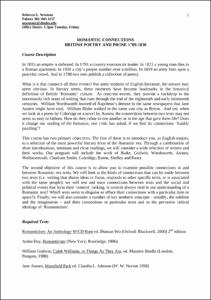Please use this identifier to cite or link to this item:
http://hdl.handle.net/10267/14008| Title: | ENGL 350-01, Romantic Connections, Fall 2005 |
| Authors: | Newman, Rebecca E. |
| Keywords: | English, Department of;Syllabus;Curriculum;Academic departments;Text;2005 Fall |
| Issue Date: | 29-Aug-2005 |
| Publisher: | Memphis, Tenn. : Rhodes College |
| Series/Report no.: | Syllabi CRN; |
| Abstract: | In 1815 an empire is defeated. In 1793 a country executes its leader. In 1821 a young man dies in a Roman apartment. In 1800 a city’s people number over a million. In 1819 an army fires upon a peaceful crowd. And in 1798 two men publish a collection of poetry. What is it that connects all these events? For some students of English literature, the answer may seem obvious. In literary terms, these moments have become landmarks in the historical definition of British ‘Romantic’ culture. As concrete events, they provide a backdrop to the enormously rich seam of writing that runs through the end of the eighteenth and early nineteenth centuries. William Wordsworth learned of Napoleon’s demise in the same newspapers that Jane Austen might have read. William Blake walked in the same vast city as Byron. And yet, when we look at a poem by Coleridge or a novel by Austen, the connections between two texts may not seem so easy to fathom. How do they relate to one another or to the age that gave them life? Does it change our reading of the literature, one critic has asked, if we find its connections ‘frankly puzzling’? This course has two primary objectives. The first of these is to introduce you, as English majors, to a selection of the most powerful literary texts of the Romantic era. Through a combination of short introductions, seminars and close readings, we will consider a wide selection of writers and their works. Our program will include the work of Blake, Godwin, Wordsworth, Austen, Wollstonecraft, Charlotte Smith, Coleridge, Byron, Shelley and Keats. The second objective of this course is to allow you to examine possible connections in and between Romantic–era texts. We will look at the kinds of connections that can be made between two texts (i.e. writing that shares ideas or focus, responds to other specific texts, or is associated with the same people); we will test and trace connections between texts and the social and political events that form their ‘context’ (asking, is context always vital to our understanding of a Romantic text? Which texts seem to disguise or efface their connections with a particular time or space?). Finally, we will also consider a number of key aesthetic concepts – notably, the sublime and the imagination – and their connections to particular texts and to the pervasive critical ideology of ‘Romanticism’. |
| Description: | This syllabus was submitted to the Office of Academic Affairs by the course instructor. |
| URI: | http://hdl.handle.net/10267/14008 |
| Appears in Collections: | Course Syllabi |
Files in This Item:
| File | Description | Size | Format | |
|---|---|---|---|---|
| 2005_fall_ENGL_350-01.pdf | 61.28 kB | Adobe PDF |  View/Open |
Items in DSpace are protected by copyright, with all rights reserved, unless otherwise indicated.